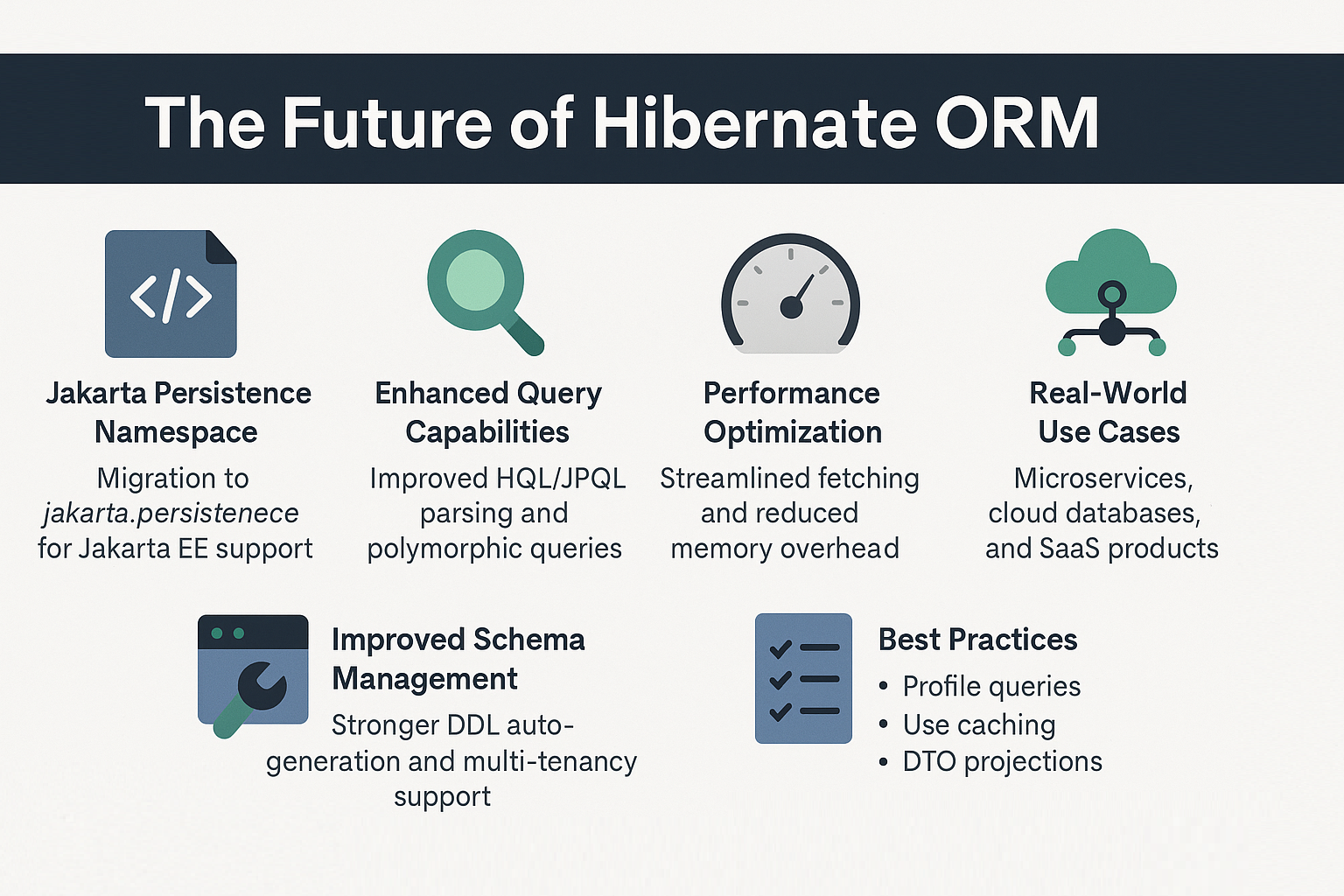Hibernate ORM has long been the go-to Object Relational Mapping (ORM) framework for Java developers. It abstracts away the complexities of database interaction, allowing developers to work with Java objects instead of raw SQL. With the release of Hibernate 6, the framework is entering a new era — bringing Jakarta Persistence support, improved query capabilities, and better performance optimizations.
In this tutorial, we’ll dive into the future of Hibernate ORM by exploring Hibernate 6+ and what lies ahead. We’ll examine its role in modern enterprise applications, highlight new features, compare it with Hibernate 5, and outline best practices for building production-ready systems.
Core Enhancements in Hibernate 6+
1. Jakarta Persistence Namespace
- Hibernate 6 migrates from the old
javax.persistenceto the newjakarta.persistencenamespace. - This change aligns with Jakarta EE standards, ensuring compatibility with the future Java ecosystem.
import jakarta.persistence.Entity;
import jakarta.persistence.Id;
@Entity
public class Product {
@Id
private Long id;
private String name;
}
2. Enhanced Query Capabilities
- Introduction of improved HQL/JPQL parsing.
- Support for polymorphic queries and SQL AST (Abstract Syntax Tree).
- More powerful Criteria API enhancements.
3. Performance and Fetching Strategies
- Optimized handling of batch fetching and JOINs.
- Better support for streaming results (important for handling large datasets).
- Reduced memory overhead for complex queries.
4. Improved Schema Management
- Stronger DDL auto-generation tools.
- Better multi-tenancy support for SaaS applications.
CRUD Example in Hibernate 6
Below is a basic example demonstrating Hibernate 6 CRUD with annotations.
import jakarta.persistence.*;
@Entity
@Table(name = "users")
public class User {
@Id
@GeneratedValue(strategy = GenerationType.IDENTITY)
private Long id;
private String name;
private String email;
// getters and setters
}
Save (Create)
User user = new User();
user.setName("Alice");
user.setEmail("alice@example.com");
Session session = sessionFactory.openSession();
Transaction tx = session.beginTransaction();
session.persist(user);
tx.commit();
session.close();
Read
Session session = sessionFactory.openSession();
User user = session.get(User.class, 1L);
session.close();
Update
session = sessionFactory.openSession();
tx = session.beginTransaction();
user.setEmail("alice@newmail.com");
session.merge(user);
tx.commit();
session.close();
Delete
session = sessionFactory.openSession();
tx = session.beginTransaction();
session.remove(user);
tx.commit();
session.close();
Querying in Hibernate 6
HQL Example
List<User> users = session.createQuery("FROM User u WHERE u.email LIKE :email", User.class)
.setParameter("email", "%example.com")
.getResultList();
Criteria API Example
CriteriaBuilder cb = session.getCriteriaBuilder();
CriteriaQuery<User> query = cb.createQuery(User.class);
Root<User> root = query.from(User.class);
query.select(root).where(cb.like(root.get("email"), "%example.com"));
List<User> users = session.createQuery(query).getResultList();
Real-World Use Cases
- Microservices: Hibernate 6’s optimized query handling works well for distributed data services.
- Cloud Databases: Better compatibility with AWS RDS, GCP Cloud SQL, and Azure databases.
- Big Data Applications: Streaming queries improve data pipeline integrations.
- SaaS Products: Improved multi-tenancy simplifies building apps for multiple clients.
Anti-Patterns & Pitfalls
- Eager Fetching Abuse → Loads unnecessary data. Prefer
LAZYfetching. - N+1 Select Problem → Use
JOIN FETCHorEntityGraph. - Improper Cascade Types → Misusing
CascadeType.ALLcan lead to unwanted deletions. - Ignoring Batching → Forgetting to configure batching slows performance.
- Unoptimized Queries → Overreliance on HQL without profiling.
Best Practices for Hibernate 6+
- Always profile SQL queries with tools like p6spy, VisualVM, or JProfiler.
- Use second-level caching (e.g., Ehcache, Infinispan).
- Prefer
@BatchSizefor optimizing collection fetching. - Write integration tests with real databases (not just H2).
- Use DTO projections for read-heavy operations.
📌 Hibernate Version Notes
Hibernate 5.x
javax.persistencenamespace.- Legacy APIs for
SessionFactoryconfiguration. - Limited Criteria API features.
- Weaker support for modern SQL dialects.
Hibernate 6.x
jakarta.persistencenamespace.- New query API with SQL AST.
- Stronger streaming and batching support.
- Improved DDL and schema management.
- More efficient handling of
Sessionlifecycle.
Conclusion & Key Takeaways
Hibernate 6 is not just an incremental upgrade; it’s a paradigm shift in ORM for Java. It ensures future-proofing with Jakarta standards, introduces smarter querying, and delivers performance enhancements crucial for enterprise and cloud-native applications.
As Hibernate evolves beyond version 6, we can expect even tighter integration with cloud-native stacks, microservices, and modern persistence paradigms.
✅ Hibernate 6 moves Java ORM into the Jakarta era.
✅ Smarter queries and streaming make it cloud and data-pipeline friendly.
✅ Developers must adapt codebases to embrace namespace and API changes.
